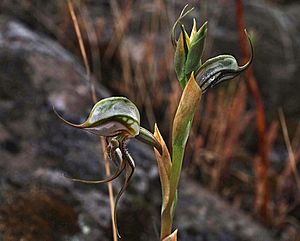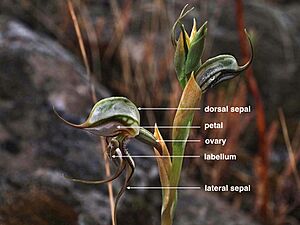Basalt rustyhood facts for kids
Quick facts for kids Basalt rustyhood |
|
|---|---|
 |
|
| Pterostylis basaltica growing near Woorndoo | |
| Conservation status | |
| Scientific classification | |
| Genus: |
Pterostylis
|
| Species: |
basaltica
|
| Synonyms | |
|
Oligochaetochilus basalticus (D.L.Jones & M.A.Clem.) D.L.Jones & M.A.Clem. |
|
The basalt rustyhood, also known as the basalt greenhood, is a special plant. It belongs to the orchid family and is found only in Victoria, Australia. This orchid has a group of leaves at its base that form a circle, like a rosette. It produces eight to fifteen beautiful, see-through white flowers. These flowers have green and brown marks and a brownish, insect-like "lip" called a labellum. The basalt rustyhood is a very rare plant. It grows in only a small area and is considered endangered.
What it Looks Like
The basalt rustyhood, or Pterostylis basaltica, is a plant that grows from an underground tuber. It is a perennial herb, meaning it lives for more than two years. It is also deciduous, so its leaves fall off at certain times.
At the bottom of the flowering stem, there is a rosette of eight to fifteen leaves. Each leaf is about 15 to 30 millimeters (0.6 to 1.2 inches) long and 6 to 9 millimeters (0.2 to 0.4 inches) wide. These leaves are shaped like an egg and come to a point. They usually dry up and disappear by the time the flowers open.
The plant can grow up to 300 millimeters (12 inches) tall. It has three to five stem leaves wrapped around its flowering spike. Up to fifteen flowers grow on this spike. Each flower is translucent white with green and brown markings. They are about 30 to 35 millimeters (1.2 to 1.4 inches) long and 9 to 12 millimeters (0.4 to 0.5 inches) wide.
The top part of the flower, called the dorsal sepal, and the petals form a hood over the center of the flower. This hood has an upturned point that is 6 to 9 millimeters (0.2 to 0.4 inches) long. The side sepals point downwards and are mostly parallel to each other. They are joined at their bases and have a few short white hairs. These side sepals also have thin, thread-like tips that are 12 to 15 millimeters (0.5 to 0.6 inches) long and spread apart.
The most interesting part is the labellum, or "lip," of the flower. It is thick, brownish, and looks a bit like an insect. It's about 5 millimeters (0.2 inches) long and 3 millimeters (0.1 inches) wide. This labellum has six to eight pairs of white hairs spreading out from its sides. There are also four shorter hairs on the swollen "head" end. These orchids usually bloom from November to December.
How it Got its Name
The scientific name Pterostylis basaltica was first officially described in 1993. This was done by two botanists, David Jones and Mark Clements. They described it from a plant they found near Woorndoo. Their description was published in a science journal called Muelleria.
The second part of its scientific name, basaltica, tells us something important about the plant. It refers to the basalt soils where this orchid usually grows. Basalt is a type of dark, volcanic rock.
Where it Lives
The basalt rustyhood is only found in a very small area in south-western Victoria. Specifically, it is known from just two groups of plants near Derrinallum. These plants grow in grasslands that are on western basalt plains. This means they grow in flat areas with soil made from volcanic rock.
Protecting the Basalt Rustyhood
This orchid is quite rare and needs our help to survive. One group of P. basaltica plants grows along a roadside and has about 1,000 plants. The other group, with only about 20 plants, is on private land. None of these plants are currently protected within a special conservation area.
The biggest dangers to the basalt rustyhood include:
- Weed invasion: Other plants (weeds) can grow and take over the orchid's space and resources.
- Habitat disturbance: Things like construction or farming can damage the places where the orchids grow.
- Altered fire patterns: Changes in how often or how intensely fires happen can harm the plants.
- Grazing: Animals eating the plants can reduce their numbers.
Because of these threats, the Victorian Government has classified the species as "Threatened." The Australian Government also lists it as "Endangered" (EN) under the Environment Protection and Biodiversity Conservation Act 1999 (EPBC Act). This means it is at a very high risk of disappearing forever. To help save it, a special plan has been created to protect and help the basalt rustyhood recover.



